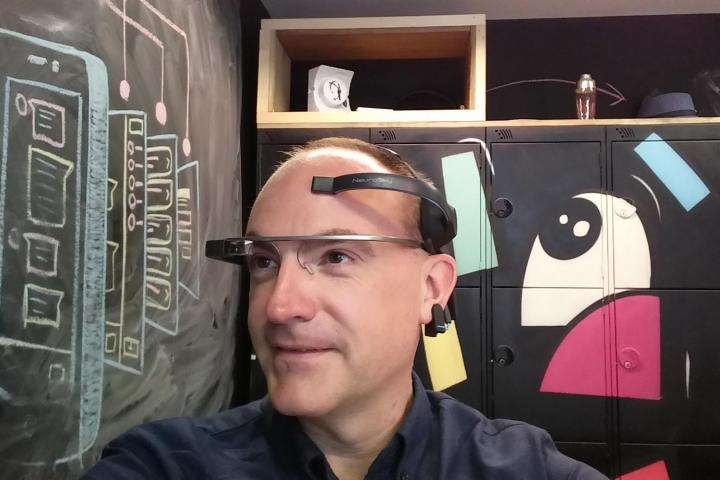
Like a teenager fumbling around with his first girlfriend, the excitement caused my brain activity to spike, and off went the camera shutter.
Using this app, and a small peripheral, you can take a picture by simply thinking about it.
I spoke with Hamlin before trying out MindRDR, and he put its ability, and potential impact, into perspective. Science fiction movies often show the future as a place filled with gesture-controlled touchscreens, Dusan explained. But the actual future may not be like Minority Report at all. We may use our minds to control everything.
Think hard
It’s not science fiction, either. The technology is already available, and for a reasonable sum, too. The version of MindRDR I used was based on a £50 telekinetic headband, which monitors four different areas of the brain using a couple of sensors. Spend £500, and you get a device that monitors 18 areas of the brain, expanding the possibilities almost endlessly.
After listening to Hamlin, I was eager to unleash the power of my mind. I slipped the headband on, ensuring the front sensor was in contact with my forehead, and connected a clip to my ear. Glass went on next, and almost instantly, I took a picture. I didn’t touch anything, it just happened. Like a teenager fumbling around with his first girlfriend, the excitement caused my brain activity to spike, and off went the shutter.
Related: What it’s like to tour one of Google’s hidden, strange Glass stores
Getting it to work a second time wasn’t so easy. It’s not really about thinking “take a picture,” because the device doesn’t read your mind, and the brainwaves produced in normal conversion aren’t enough to make it work. It’s all about finding a trigger which sufficiently wakes up your brain. Glass’ display shows the camera view, overlaid with a horizontal line that raises and lowers depending on how hard your brain is working. It’s calibrated so a significant spike is needed to take a picture, otherwise it would go off all the time.
Fear and anxiety
MindRDR provides a fascinating glimpse at how the brain operates. During normal conversations the line didn’t pass the mid-way point, and was nowhere near volatile enough to take a picture. The trick is to find something that works for you. Fear or anxiety turned out to do the job rather well. Dusan said for the first few weeks, recalling an argument he had with his mother when he was young used to be enough to get the camera working, while someone else imagined talking on stage in front of a crowd. For me, it was imagining writing the first line of a feature, the part I find the most difficult.
As it turns out, taking a mind-controlled picture is a lot like a twisted version of how Peter Pan learns how to fly. Instead of a happy thought, you usually need an angry one.
It takes practice, and you are acutely aware of making your brain work, but unlike flexing a muscle, you don’t actually feel it. This makes it odd when you find the trigger. Once the picture is taken, the option to share it on a social network is presented, which requires another spike to perform. When you get the hang of revving up your brain, you can start to take pictures that actually look good. What’s more, practice improves your performance, and lowers the time it takes to activate the camera. It’s not surprising to hear the brain monitoring headband has been used as a “brain training” tool in the past.
It’s already changing lives
Using MindRDR is a truly futuristic experience, but I don’t need my mind to press a shutter release, because I have the use of my hands. Right now, MindRDR is designed for those who don’t, and this technology could open up a whole new world. Hamlin talked specifically about quadriplegics, and people who suffer from lock-in syndrome, as those who already benefit from it. He receives emails from people who never thought they’d take a photograph again, but now had the chance to do so.
Excitingly, the software developed at This Place is open source, so anyone can tinker with it, plus the whole project was only possible because of Google’s openness with Glass. There are much larger companies interested in working on the technology with This Place, and because Hamlin isn’t really in it for profit at the moment, he’s happy to work with the right people.
Related: 6 wearables that are helping people live with dangerous health conditions
Even at this early stage, MindRDR is changing people’s lives. In the future, as the whole setup becomes more mature, compact, and affordable, it may radically change the way we interact with all kinds of devices — provided we can all think of enough things that scare the hell out of us, that is.





